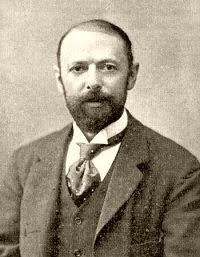Philosophy
 Frederic Eugene Ives
Frederic Eugene Ives
February 17th, 1856 to May 27th, 1937

Have you ever watched the Antiques Road Show? Sure you have, hoping that your junk in the closet is worth a zillion dollars but alas, your goods are worthless. And it is fun to watch the Keno brothers [Leigh and Leslie (there is a third, but is rarely seen)] have an orgasm when they spot a broken old chair that George Washington sat on or that yellowed semi-nude photograph is really a snap of Wyatt Earp's wife.
Now enters a guest who has spent several thousand dollars for a large circus poster that he believes is from the late 19th Century. It is in decent shape physically...too good as a matter of fact. The density and color saturation of the print is soft [much like the difference between a Kodachrome 35mm slide and an Ektachrome 35mm slide...the Kodachrome being much more saturated in density and color]. There isn't a single blemish anywhere on the poster. Now, either Nicholas Lowry or Gary Sohmers [poster experts] arrive to evaluate the product.
"Ah, a circus poster. Well, it is in good condition. How much did you pay for it."
"I bought it at an antique shop for about $2,000 in 1964."
"I see. Well, I must inform you that this circus poster is worth between $12.50 to $15.00. You ignoramus, you really got honked."
How did he analyze the poster and come to that evaluation? A loop magnifier provided a simple solution...he saw thousands of small dots. The circus poster was a photo lithographic print [cheaply made] not an original product of hand engraved plates.
Segue to "photography" and "lithography" and Frederic Eugene Ives...and the "half-tone" process. Frederic Eugene Ives was an American photographer and inventor of the "half-tone process", a method of reproducing photographs on a printing press. Prior to this process, photos and illustrations were reproduced from hand-engraved plates. In this way the printers could reproduce line drawings, but not the shades of gray in a photograph because printing presses cannot print gray - only black and white. Ives invented a screen that would convert a photograph into a pattern of small dots. Large dots form where the image is dark and small dots where the image is light, thus giving the illusion of shades of gray. And in 1881 he was the first to make a three-color print from halftone blocks. Without this dot-matrix half-tone process all printing process using continuous tone images [black and white or color] would have been impossible.
- If You Go Hanging Pictures Of Chairman Mao, You Ain't Gonna Make It With Anyone Anyhow
Ethical question today. A student of mine just returned from a research trip to China. I donated a bunch of books for her to take (English language books, especially logic books apparently, are in short supply and, when given as gifts at universities,...
- Butt, Butt, Butt...i Don't Have £15,500
"Athena 'tennis girl' poster dress sells for £15,500 at auction" Dress featured in classic 1970s poster fetches eight times its original estimate with racquet by Chris Johnston July 5th, 2014 theguardian.com The white minidress...
- Kodachrome Film...died In Parsons, Kansas
The Inventors Hall of Fame photos of Leopold Godowsky, Jr. (left), and Leopold Mannes, inventors of Kodachrome. Despite their success in photography, both Leopolds considered themselves musicians first and inventors second. Below, Kodachrome packaging...
- Kodachrome--gone
All good things must come to an end. Eastman will dump Kodachrome film as it has done many other products like the fantastic Blue Toner [contained uranium nitrate that could actually make red prints], fabulous black and white printing papers [Extalure,...
- First Astronomy Photograph--daguerreotype Of The Moon
Earliest known photograph of the Moon...a daguerreotype taken in 1851. John Adams Whipple [Louis Daguerre took the first photograph of the Moon in 1839 but none survive for on March 8, 1839 Daguerre's laboratory burned to the ground, destroying the...
Philosophy
Frederic Eugene Ives...revolution in lithography
 Frederic Eugene Ives
Frederic Eugene IvesFebruary 17th, 1856 to May 27th, 1937

Without Ives invention the above photograph could not have been mass reproduced in magazines and journals.
Have you ever watched the Antiques Road Show? Sure you have, hoping that your junk in the closet is worth a zillion dollars but alas, your goods are worthless. And it is fun to watch the Keno brothers [Leigh and Leslie (there is a third, but is rarely seen)] have an orgasm when they spot a broken old chair that George Washington sat on or that yellowed semi-nude photograph is really a snap of Wyatt Earp's wife.
Now enters a guest who has spent several thousand dollars for a large circus poster that he believes is from the late 19th Century. It is in decent shape physically...too good as a matter of fact. The density and color saturation of the print is soft [much like the difference between a Kodachrome 35mm slide and an Ektachrome 35mm slide...the Kodachrome being much more saturated in density and color]. There isn't a single blemish anywhere on the poster. Now, either Nicholas Lowry or Gary Sohmers [poster experts] arrive to evaluate the product.
"Ah, a circus poster. Well, it is in good condition. How much did you pay for it."
"I bought it at an antique shop for about $2,000 in 1964."
"I see. Well, I must inform you that this circus poster is worth between $12.50 to $15.00. You ignoramus, you really got honked."
How did he analyze the poster and come to that evaluation? A loop magnifier provided a simple solution...he saw thousands of small dots. The circus poster was a photo lithographic print [cheaply made] not an original product of hand engraved plates.
Segue to "photography" and "lithography" and Frederic Eugene Ives...and the "half-tone" process. Frederic Eugene Ives was an American photographer and inventor of the "half-tone process", a method of reproducing photographs on a printing press. Prior to this process, photos and illustrations were reproduced from hand-engraved plates. In this way the printers could reproduce line drawings, but not the shades of gray in a photograph because printing presses cannot print gray - only black and white. Ives invented a screen that would convert a photograph into a pattern of small dots. Large dots form where the image is dark and small dots where the image is light, thus giving the illusion of shades of gray. And in 1881 he was the first to make a three-color print from halftone blocks. Without this dot-matrix half-tone process all printing process using continuous tone images [black and white or color] would have been impossible.
- If You Go Hanging Pictures Of Chairman Mao, You Ain't Gonna Make It With Anyone Anyhow
Ethical question today. A student of mine just returned from a research trip to China. I donated a bunch of books for her to take (English language books, especially logic books apparently, are in short supply and, when given as gifts at universities,...
- Butt, Butt, Butt...i Don't Have £15,500
"Athena 'tennis girl' poster dress sells for £15,500 at auction" Dress featured in classic 1970s poster fetches eight times its original estimate with racquet by Chris Johnston July 5th, 2014 theguardian.com The white minidress...
- Kodachrome Film...died In Parsons, Kansas
The Inventors Hall of Fame photos of Leopold Godowsky, Jr. (left), and Leopold Mannes, inventors of Kodachrome. Despite their success in photography, both Leopolds considered themselves musicians first and inventors second. Below, Kodachrome packaging...
- Kodachrome--gone
All good things must come to an end. Eastman will dump Kodachrome film as it has done many other products like the fantastic Blue Toner [contained uranium nitrate that could actually make red prints], fabulous black and white printing papers [Extalure,...
- First Astronomy Photograph--daguerreotype Of The Moon
Earliest known photograph of the Moon...a daguerreotype taken in 1851. John Adams Whipple [Louis Daguerre took the first photograph of the Moon in 1839 but none survive for on March 8, 1839 Daguerre's laboratory burned to the ground, destroying the...
